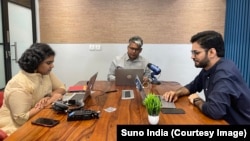Working for global nonprofits in the early 2000s, Padma Priya and her colleagues Rakesh Kamal and Tarun Nirwan noticed that the regular news cycle didn’t always reflect day-to-day life.
“We were seeing these very real issues being played out and people and communities being impacted, but their stories were not really coming out and not getting the prominence that they deserve,” Priya told VOA.
So in 2018, the team launched Suno India to bring attention to underreported stories in a format easily accessible to broad audiences: Podcasts.
“We were all avid podcast listeners, and we knew that podcasts can make an impact, can get through to people, can give a break from the screen,” she said.
At that time, few outlets in India were producing audio journalism. With all FM news stations in the country controlled by the government-run All India Radio, podcasts offered a platform not previously available to independent journalists.
Despite coming from a print background — Priya has worked for outlets including The Hindu and The Wire — the journalist and her co-founders found the medium easy to work with.
It’s a format that helped them bring diverse voices into the newsroom and start a fellowship for early and mid-career journalists.
Another unexpected benefit: Sources are often more willing to participate when they don’t have to appear on camera.
“I saw that this was a medium which gives an anonymity to people,” Priya told VOA. “And the kind of topics we have chosen, and we continue to choose, sometimes are sensitive. Not everybody is willing to put their face in front of a camera, but they're willing to lend their voice.”
Broad reach
Suno India covers issues including adoption, tuberculosis and rare diseases. The team also reports on climate change, the economy, and what they call “cyber democracy”—the intersection of digital rights and democracy.
To date, they’ve produced about 25 series, and they broadcast in English, Hindi and Telugu.
Most listeners come to the podcast to understand issues in their communities, but Priya said policymakers, doctors, and other stakeholders also listen in for factual reporting on bigger societal problems.
Despite their broad reach, podcasts remain an “intimate form of communication and storytelling,” said Mary Fitzgerald, director of expression for Open Society Foundations, an organization that provides funding and other support to independent groups, including journalists.
Audio portrays nuance in a way that print journalism cannot, creating an experience that comes across as both vivid and personal, said Fitzgerald.
In India, podcasts have helped outlets like Suno India to reach communities and cover underreported stories. But in more repressive countries, the medium can play an additional role.
“Podcasts are much harder to censor. They’re much harder to target the makers of,” Fitzgerald told VOA.
Speaking broadly about how podcasting can help media globally, Fitzgerald said, “You can podcast from one location and reach audiences that might be in a very repressive environment. And you can cut through the propaganda or censorship that those populations might be subjected to.”
The medium can also help journalists to gather and share news when it is difficult to have reporters out in the field.
When protests erupted in India in 2019 over a new citizenship law and the internet was restricted in certain areas of the country, the team at Suno India used the messaging app WhatsApp to connect with sources.
Reporters sent questions as voice notes that their sources could download and respond to after they’d reached areas with internet access.
“We realized there was a lot of power in using WhatsApp voice messages in this way,” said Priya.
The method proved useful again during the pandemic lockdowns when millions of migrant workers fled cities for remote villages.
With in-person meetings no longer an option, Suno India relied on WhatsApp to conduct interviews and get the news out.
Priya and her team connected with farmers in rural regions who, during harvest season in March and April 2020, were not permitted in the fields due to the lockdowns. Through voice notes, the farmers were able to share their challenges and coping methods with podcast listeners.
Similarly, the team was able to connect with doctors in Kashmir when high-speed internet bans were instituted after Delhi revoked the region’s autonomous status.
“Of course, the best thing would be to go there and sit in front of a person and report, but that's not always possible,” Priya said. “For us during those times, [WhatsApp messaging] seemed like the only way to get those voices in and keep the reporting going.”
For independent news outlets in India, foreign funding is prohibited, and finding the financial means to keep reporting can be a challenge.
Priya said just as it’s the responsibility of journalists to produce factual, well-researched content, it’s the listeners’ responsibility to support their local newsrooms.
“We've seen that not investing in the right kind of media means there’s going to be more misinformation. There's going to be more propaganda. There's going to be more fake news. And that has direct repercussions on government officials getting elected, on democracy itself, and on civil liberties,” Priya said.











